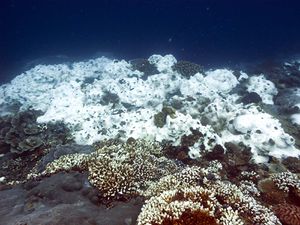Coral microbial ecology: Difference between revisions
| Line 26: | Line 26: | ||
==References== | ==References== | ||
1. Kellog, Christiana. "Coral Microbial Ecology." St. Petersburg Coastal and Marine Science Center. U.S. Geological Survey, 22 Nov 2013. Web. 4 Dec 2013. | 1. Kellog, Christiana. "Coral Microbial Ecology." St. Petersburg Coastal and Marine Science Center. U.S. Geological Survey, 22 Nov 2013. Web. 4 Dec 2013. | ||
2."Coral Reefs and Resilience- What is Resilience?." Reef Resilience . The Nature Conservancy , n.d. Web. 4 Dec 2013. | 2."Coral Reefs and Resilience- What is Resilience?." Reef Resilience . The Nature Conservancy , n.d. Web. 4 Dec 2013. | ||
Revision as of 00:02, 5 December 2013
Introduction
Corals are invertebrate marine animals belonging to the phyla Cnidaria and class Anthozoa. They thrive in salty ocean water. Although some corals have been found as deep as 91 m (300 ft), most live optimally at shallower depths of 70 m (230 ft) or less. Corals are either soft or hard, but reefs form only with the presence of hard coral. Soft coral doesn't have the capability to make reefs but still may be present. Hard corals have a calcium carbonate skeleton. The microbial community found in coral reefs are co-habitating, non-pathogenic, and consist of bacteria, archaea, and fungi. They live in the mucus, tissue, and skeleton of coral. These microbes effect the ecosystem's food webs, life cycles, chemical cycles, nutrient cycles, and regulation of pathogenic microbes, which are important factors in coral resilience. Coral microbial ecology studies these relationships between corals and microorganisms in the hope of understanding coral resilience and disease to protect a valuable, biologically diverse ecosystem as well as to identify and predict environmental change.

Zooxanthellae Symbiosis
Zooxanthellae are single-cell photosynthetic algae that live in the coral's gastrodermis, the tissue covering the gastrovascular cavity. Coral and zooanthellae have a positive symbiotic relationship. Most of the coral's food intake is reliant on the products of the zooxanthellae's photosynthesis. In return for the food source, these microbes get a place to live. The pigment of coral is also a product of healthy zooxanthellae.
Disease
Include some current research, with at least one image.
Bleaching
Under stress, such as a shift in water temperature or salinity or even excess of sediment, nutrients, or chemicals, zooxanthellae are expelled from the coral. This causes the coral to lose it's color by revealing the coral's white calcium carbonate skeleton. The whitened coral is said to be 'bleached.' If the stress continues, the coral may die. However, once the stress is reduced or eliminated, the zooxanthellae will return to the coral and restore it back to health. Bleached coral is believed to be more susceptible to disease.

Resilience
Current Research
Overall text length should be at least 1,000 words (before counting references), with at least 2 images. Include at least 5 references under Reference section.
References
1. Kellog, Christiana. "Coral Microbial Ecology." St. Petersburg Coastal and Marine Science Center. U.S. Geological Survey, 22 Nov 2013. Web. 4 Dec 2013. 2."Coral Reefs and Resilience- What is Resilience?." Reef Resilience . The Nature Conservancy , n.d. Web. 4 Dec 2013. 3. "About Corals." Coral Reef Systems. Sripps Institution of Oceanography , n.d. Web. 4 Dec 2013. <http://coralreefsystems.org/content/about-corals>. 4. "Coral Disease- Coral Bleaching." St. Petersburg Coastal and Marine Science Center. U.S. Geological Survey, 22 Nov 2013. Web. 4 Dec 2013. 5. "Coral Disease- Black-Band Disease." St. Petersburg Coastal and Marine Science Center. U.S. Geological Survey, 22 Nov 2013. Web. 4 Dec 2013. 6. "Coral Associated Microbes." St. Petersburg Coastal and Marine Science Center. U.S. Geological Survey, 22 Nov 2013. Web. 4 Dec 2013.
Edited by Emily Stegner, student of Joan Slonczewski for BIOL 116 Information in Living Systems, 2013, Kenyon College.
